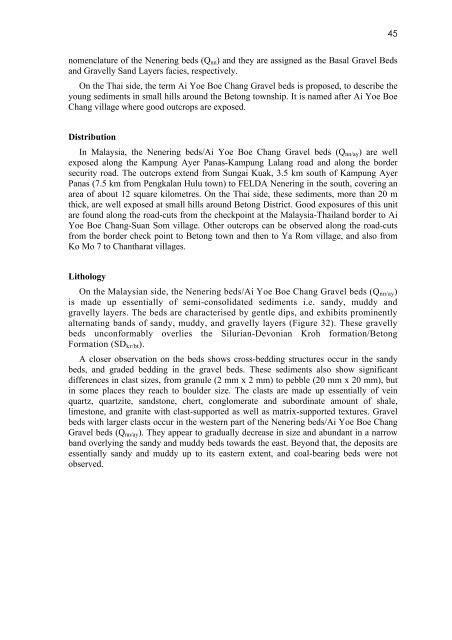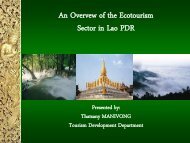GEOLOGY OF THE PENGKALAN HULU-BETONG TRANSECT ...
GEOLOGY OF THE PENGKALAN HULU-BETONG TRANSECT ...
GEOLOGY OF THE PENGKALAN HULU-BETONG TRANSECT ...
Create successful ePaper yourself
Turn your PDF publications into a flip-book with our unique Google optimized e-Paper software.
nomenclature of the Nenering beds (Qnn) and they are assigned as the Basal Gravel Beds<br />
and Gravelly Sand Layers facies, respectively.<br />
On the Thai side, the term Ai Yoe Boe Chang Gravel beds is proposed, to describe the<br />
young sediments in small hills around the Betong township. It is named after Ai Yoe Boe<br />
Chang village where good outcrops are exposed.<br />
Distribution<br />
In Malaysia, the Nenering beds/Ai Yoe Boe Chang Gravel beds (Qnn/ay) are well<br />
exposed along the Kampung Ayer Panas-Kampung Lalang road and along the border<br />
security road. The outcrops extend from Sungai Kuak, 3.5 km south of Kampung Ayer<br />
Panas (7.5 km from Pengkalan Hulu town) to FELDA Nenering in the south, covering an<br />
area of about 12 square kilometres. On the Thai side, these sediments, more than 20 m<br />
thick, are well exposed at small hills around Betong District. Good exposures of this unit<br />
are found along the road-cuts from the checkpoint at the Malaysia-Thailand border to Ai<br />
Yoe Boe Chang-Suan Som village. Other outcrops can be observed along the road-cuts<br />
from the border check point to Betong town and then to Ya Rom village, and also from<br />
Ko Mo 7 to Chantharat villages.<br />
Lithology<br />
On the Malaysian side, the Nenering beds/Ai Yoe Boe Chang Gravel beds (Qnn/ay)<br />
is made up essentially of semi-consolidated sediments i.e. sandy, muddy and<br />
gravelly layers. The beds are characterised by gentle dips, and exhibits prominently<br />
alternating bands of sandy, muddy, and gravelly layers (Figure 32). These gravelly<br />
beds unconformably overlies the Silurian-Devonian Kroh formation/Betong<br />
Formation (SDkr/bt).<br />
A closer observation on the beds shows cross-bedding structures occur in the sandy<br />
beds, and graded bedding in the gravel beds. These sediments also show significant<br />
differences in clast sizes, from granule (2 mm x 2 mm) to pebble (20 mm x 20 mm), but<br />
in some places they reach to boulder size. The clasts are made up essentially of vein<br />
quartz, quartzite, sandstone, chert, conglomerate and subordinate amount of shale,<br />
limestone, and granite with clast-supported as well as matrix-supported textures. Gravel<br />
beds with larger clasts occur in the western part of the Nenering beds/Ai Yoe Boe Chang<br />
Gravel beds (Qnn/ay). They appear to gradually decrease in size and abundant in a narrow<br />
band overlying the sandy and muddy beds towards the east. Beyond that, the deposits are<br />
essentially sandy and muddy up to its eastern extent, and coal-bearing beds were not<br />
observed.<br />
45



